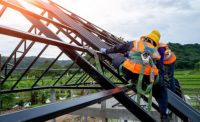Oil and gas processing involves some of the most challenging working conditions, which is why safety for oil and gas workers is critical. Plant sites can involve working in confined spaces, on slick surfaces, using dangerous gases and chemicals, and working with numerous types of equipment and machinery, all of which can pose health and safety risks.
Furthermore, when normal operations give way to planned or unplanned turnarounds or shutdowns for maintenance, there are even greater risks of worker injuries. With more workers onsite for repairs and tight schedules to adhere to, and when every hour of downtime impacts the bottom line, creating a safe environment is essential so that workers can do their jobs safely and efficiently in order to return facilities back to peak performance quickly.
Whether performing day-to-day tasks on the job or repairing broken equipment, draining pipes, cleaning tanks, hydroblasting and welding metals together, workers need personal protective equipment (PPE) they can trust to help keep them safe.
Protecting against inhaling dangerous gases
Workers on oil and gas plants can be exposed every day to a wide spectrum of gases while on the job, which can result in fatalities if breathed in depending on the gas exposed to and its concentration. And for those working in confined spaces such as tanks or pipelines, risk of exposure to toxic gases increases significantly due to poor ventilation where gases can build up over time.
Depending on the working environments, full-face respirators and powered air purifying respirators can be used to help prevent breathing in toxic gases and fumes. Furthermore, respiratory protection should always be combined with fixed and portable gas detection devices to alert workers when dangerous gases are present so that they can take steps to evacuate unsafe environments. By combining technologies, workers can benefit from timely detection and ultimately life protection, allowing them to return home safely after each shift.
Protecting against falls from heights
Across oil and gas operations, workers are exposed to scenarios where they could encounter a fall as they may need to access equipment or conduct a repair on an elevated surface high above ground. In fact, as falls from height continue to be among the leading causes of serious work-related injuries and deaths, the Occupational Safety and Health Administration has updated some of their fall protection requirements. By 2036, all fixed ladders that are more than 24 feet above the lower level and that use cages and wells as fall protection should be equipped with a personal fall arrest system or ladder safety system. Whether working in the upstream, midstream or downstream segments, oil and gas operations can have hundreds to even thousands of ladders on a single site, so knowing the fundamentals of personal fall arrest systems amid these regulatory changes is key.
There are three core components of a fall arrest system, including anchorage points, body wear and connectors. Each of these components is critical for helping protect workers at height, and if one component is missing, then the system cannot work.
Anchorage points are secure points of attachment for horizontal or vertical lifelines, lanyards and other equipment used to support workers in the event they fall. For body wear, full-body harnesses are critical. When determining which type of harness to use, consider those that are lightweight and breathable, which will help make climbing easier with less risk of muscular fatigue. Lastly, connecting devices are the attachments that connect the worker's harness to the anchorage points so that the full system can work together and provide protection if a fall occurs. Connecting devices can include shock absorbing lanyards, self-retracting devices, personal fall limiters and rope grabs.
Protecting against “hot work” hazards
Between maintenance, repair and new equipment installation, workers on oil and gas sites are often involved in one or more “hot work” projects, such as welding, cutting, brazing or soldering. In these conditions, oil and gas workers need proper protection against sparks, debris, ultraviolet rays and resulting fumes with adequate head, eye, face and respiratory protection. For maximum protection, safety managers should consider welding helmets that work in conjunction with powered air purifying respirator blowers to give workers an all-in-one welding solution from the neck up. Workers' hands are also at high risk during hot work, and so heat resistant gloves should always be used to help protect workers’ hands and fingers from burns and exposure to high temperatures.
It's important to note that for hot work on oil and gas sites in particular, workers performing these projects can be exposed to the risk of fires and explosions from the ignition of flammable or combustible gases in the space. Companies and contractors should always inspect the area before the work starts, and permits may be mandated to show that the site has been cleared for these activities.
The full spectrum of worksite dangers for oil and gas workers is wide ranging, and risks can increase during turnarounds when day-to-day work shifts to inspection, maintenance, repair, upgrades or installing new equipment. But one thing remains clear and can be applied for oil and gas workers year-round: utilizing safety best practices and implementing PPE which favors increased ease of use, durability and reliability helps keep workers safe.




